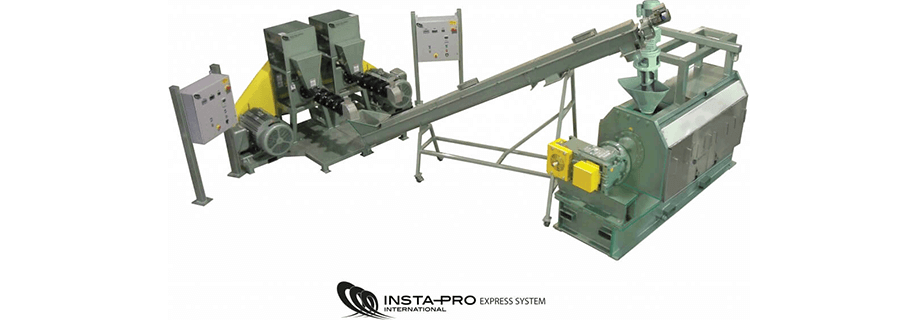Oil Pressing for Different Types of Oil Seed

There has been a lot of interest lately from existing oil press owners, concerning what is required to process different types of oil seed through their systems. The differences from one type of oil seed to the next have a direct effect on the operating parameters, which in turn effect how the seed is handled to and away from the system. It also requires changes in screw configuration for both the extruder and press and in some cases, the shim arrangement in the press cage. These changes are designed to optimize the efficiency of the oil press as it relates to oil recovery. The following will be a review of parameters, and differences from seed to seed.
Soybeans: Typically soybeans can range from 18% to as much as 21% oil content. Pre-extruded soy should be clean and less than 11% moisture. The soy should also be ground prior to extruding. Preferably the soy is rough ground or rolled into 4 or 5 pieces {no whole beans}. The soy can be fed to the extruder with an over the top, gravity type volumetric feeder. Post press handling includes grinding of the cake and cooling. If a rotary type cooler is used, the cake should be ground prior to cooling. If a counter flow type cooler is used, it’s best to grind after cooling. The screw configuration for both extruder and press are higher restriction.
Cottonseed: Typically 18% to 22 % oil. Moisture can vary widely, depending on harvest and storage conditions. Cottonseed is processed after ginning, and has some lint attached. This lint makes the seed bulky and presents some challenges in feeding it to the extruder. The seed should be as clean as possible, with any trash or dirt removed, as the fiber content of the seed makes it abrasive to begin with. In some cases the seed is extremely dry {7% or less}, and can require a small amount of water injection. The extruder and press configuration are the least restrictive of any of the express processes. The equipment feeding the extruder is not compatible with other oil seed processing. Post press handling is similar to soy; basically
Canola, Rape, Mustard and Flax type seeds: Oilseeds like canola, flax, mustard, are categorized as high-oil seeds, typically containing anywhere between 30% and 50% oil. Due to this elevated oil content, standard processing methods are not sufficient to fully extract their valuable oil. For these types of seeds, a double pass through the oil press is required. The first pass begins by feeding raw seed directly into the press prior to the extruder. This pre-extruded pass serves two purposes: it meters the raw material into the system and prepares the seed for the second, more intensive phase of extrusion and pressing. At this stage, a moderate choke setting is used to ensure optimal compression without causing seed damage. The press screw and extruder configurations are also adjusted to be less restrictive than those used for soybeans, allowing for gentler handling of the more delicate high-oil seeds. One key consideration in this process is avoiding the creation of a mushy or semi-liquid consistency, which can plug the press and reduce efficiency. By splitting the oil extraction into two stages, pressing before and after extrusion, the seed is stabilized for maximum oil recovery.
After the initial pressing, the partially defatted meal is sent through the extruder. High-shear dry extrusion ruptures additional oil cells while simultaneously cooking and conditioning the meal. This step is followed immediately by a second pass through the press, where further oil is recovered under controlled pressure. In all ExPress® systems, including those used for high-oil seeds, a properly engineered vented conveyor system is essential. We design these conveyors specifically to allow for the release of condensation and steam created during extrusion. Without this venting, the resulting moisture can cause slippage in the press, significantly decreasing oil recovery.
Additional adaptations, such as shimmed inlet chambers on the press, help prevent smaller seeds from falling through the cage bars prematurely, ensuring efficient throughput. Finally, as with other oilseed processes, the final product should go through post-extrusion cooling and grinding to prepare it for storage or further processing. By implementing this precise double-pass system, processors can optimize oil yield from high-oil seeds while maintaining equipment integrity and product quality, unlocking more value from every batch.
Sunflower: In the case of sunflower seed, the seed must be processed with the hull on. Oil content for sunflower varies widely due to seed variety and geographical location. Oil contents will be from 32% to 45%. The process for sunflower is like the other high-oil content seed; as it is done in a double pass. The first pass not extruded, the second pass extruded and pressed.
If different seed is to be run on a consistent basis, one way to speed up the changeover would be to have an extra press shaft with the different screw configuration mounted on it, so you would just change out shafts instead of taking everything apart. The same can be done with the cage. An extra cage shimmed for the particular seed, is easier to switch than reshimming the whole cage.
The Insta-Pro press manuals that you receive with your equipment have illustrations of the different shaft and cage configurations for the different kinds of oil seeds.



